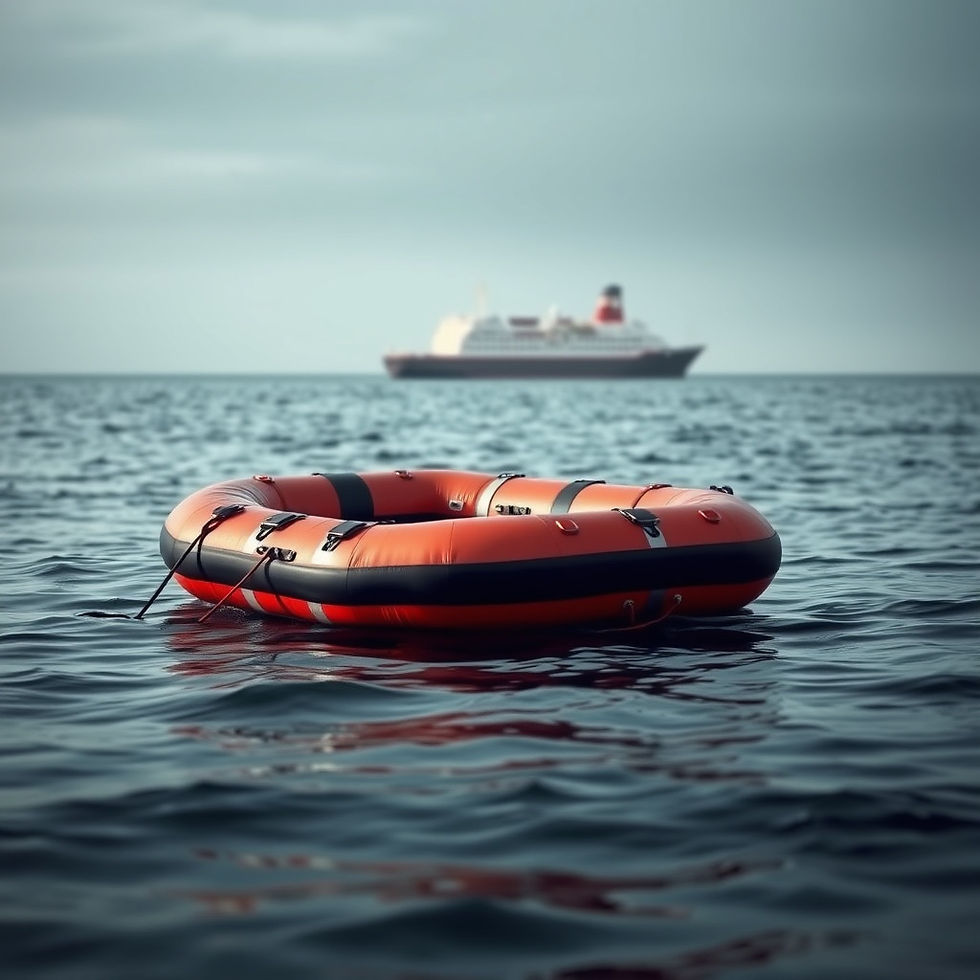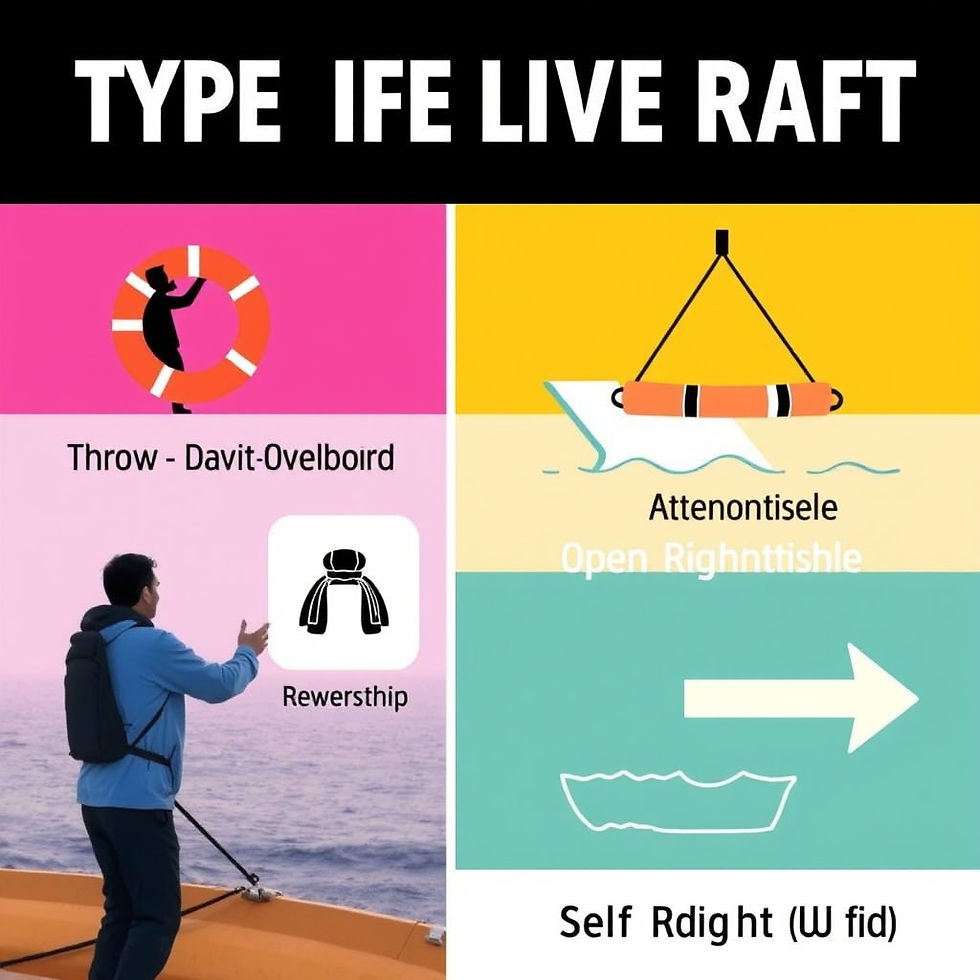Life Rafts in Maritime Safety: Your Ultimate Guide to Surviving at Sea
- kousik pattanayak

- Jun 11
- 7 min read
Updated: Aug 4

In the vast and often unpredictable expanses of the ocean, safety is a non-negotiable priority. While the sheer size and robust design of modern ships offer significant security, every vessel must be prepared for the worst. This is where life rafts come into play. As essential survival equipment on ships, life rafts ensure that crew and passengers can evacuate safely and efficiently in emergencies. Unlike rigid lifeboats, life rafts are compact, inflatable, and designed for quick deployment, serving as a last-resort survival craft when abandoning a vessel becomes the only option.
This blog post will serve as your comprehensive guide to these incredible life-saving devices. We will explore the fundamental purpose of life rafts, their types, critical working principles, stringent IMO requirements, international regulations that govern their use, the essential equipment they carry, and even their surprising alternative uses beyond emergency situations. Prepare to understand why these floating havens are indispensable for maritime safety.
What is a Life Raft & Its Purpose? Your Inflatable Haven at Sea
A life raft is a self-inflating survival craft designed to provide immediate refuge for individuals abandoning a ship. Its primary goal is to offer temporary shelter, flotation, and vital survival resources for stranded crew members and passengers until professional rescue services can arrive. In moments of extreme peril, when a ship is sinking or engulfed in fire, the ability to deploy a reliable life raft quickly can mean the difference between life and death.
Key Purposes of Life Rafts:
Emergency Evacuation: Life rafts are specifically designed for emergency evacuation – used when lifeboats are unavailable, damaged, or inaccessible, providing a crucial alternative means of escape.
Survival in Harsh Conditions: Constructed from durable, weather-resistant materials, they protect occupants from extreme weather, including severe cold, scorching sun, and driving rain, making survival in harsh conditions possible.
Buoyancy & Stability: Engineered with multiple inflation chambers, life rafts provide exceptional buoyancy & stability, keeping survivors safely afloat even in the roughest seas, preventing capsizing.
Storage of Emergency Supplies: Each raft is meticulously equipped with food, water, medical kits, and distress signals, ensuring occupants have the basic necessities to sustain themselves for an extended period until rescue.

Types of Life Rafts: Designs for Every Emergency Scenario
Life rafts come in various designs, each tailored to specific maritime conditions, vessel types, and deployment methods. The IMO (International Maritime Organization) and SOLAS (Safety of Life at Sea) regulations are the global benchmarks that define the standards for these critical rafts, ensuring their universal reliability.
1. Throw-Overboard Life Rafts
Deployment: As the name suggests, these rafts are manually thrown into the water from the ship's deck.
Use: They are common on cargo ships and passenger vessels where davit systems for lifeboats might be limited or in situations requiring rapid deployment.
Features: Once in the water, a painter line (cord) pulls, activating a CO2 cylinder, causing the raft to auto-inflate upon contact with water within seconds.
2. Davit-Launched Life Rafts
Deployment: Unlike throw-overboard types, these rafts are lowered into the water using davits (crane-like devices) from the ship's side.
Use: They are typically found on larger ships with davit systems, allowing for a controlled descent.
Features: A key advantage is that they allow crew to board before launching, providing a safer, more organized evacuation, especially for injured or less mobile persons.
3. Open Reversible Life Rafts (ORLs)
Deployment: These rafts are designed to be deployed and can be used on either side, meaning there is no "right" or "wrong" way up after inflation.
Use: They are ideal for extreme weather conditions and vessels operating in unpredictable seas where quick, hassle-free deployment is crucial.
Features: Their no fixed orientation design ensures immediate usability in rough seas, as they function effectively regardless of which side lands face up.
4. Self-Righting Life Rafts
Deployment: Similar to other types, but with an enhanced design.
Use: These rafts are specifically used in high-risk maritime operations where rough seas or extreme conditions could easily capsize a conventional raft.
Features: They are engineered to automatically correct their position if overturned, ensuring occupants remain upright and protected, even after capsizing due to waves.

Working Principle of Life Rafts: The Magic of Instant Inflation
The seemingly magical transformation of a compact canister into a sturdy life raft in seconds is thanks to sophisticated automatic inflation systems powered by compressed gas cylinders, typically filled with CO2. Here’s a simplified breakdown of the Working Principle of Life Rafts:
Activation: The life raft is deployed, either manually thrown overboard or lowered by a davit. A painter line, connected to the ship, begins to pay out.
Inflation: As the painter line tightens, a trigger mechanism within the raft’s canister activates a hydrostatic release unit (HRU). If the ship sinks, the HRU automatically releases the raft at a certain depth, triggering inflation. This system initiates the flow of compressed gas from the cylinder into the raft's chambers.
Expansion: The highly pressurized gas rapidly inflates the raft's buoyant tubes and canopy. The entire raft expands within seconds, forming a stable, multi-chambered floating platform.
Survival Mode: Once inflated and boarded, occupants enter Survival Mode, utilizing the onboard survival equipment and waiting for rescue.
IMO & SOLAS Requirements for Life Rafts: Non-Negotiable Safety Standards
The IMO and SOLAS regulations are unequivocally strict regarding life rafts, underscoring their critical role in maritime safety. According to SOLAS Chapter III (Life-Saving Appliances and Arrangements), every ship must carry a sufficient number of life rafts that meet stringent criteria:
Key IMO Requirements:
Construction: Life rafts must be built to withstand 30 days afloat in all sea conditions, enduring extreme temperatures, waves, and winds.
Drop Test: They must function properly when dropped from 18 meters (or the maximum stowage height, whichever is greater), ensuring integrity during emergency deployment from high decks.
Capacity: Each ship must carry enough life rafts to accommodate all crew members and passengers, with some excess capacity, in case of emergency evacuation.
Inflation System: As mentioned, they must auto-inflate upon contact with water, ensuring quick and reliable deployment.
Canopy Protection: A robust canopy must provide insulation against heat and cold, protecting occupants from hypothermia, hyperthermia, and harmful UV radiation.
Survival Equipment: Each raft must include comprehensive food, water, distress signals (flares), and medical kits, vital for prolonged survival.
These regulations ensure that life rafts are durable, reliable, and capable of handling emergency situations, serving as dependable havens in the vast ocean.
Essential Equipment in Life Rafts: Every Item Counts for Survival
Beyond the raft itself, the meticulous selection of life-saving gear packed inside is what truly defines a life raft as a survival craft. This equipment is designed to support survivors, assist in rescue operations, and sustain life until professional help arrives.
Standard Equipment Includes:
Emergency Rations & Drinking Water: Compact, high-energy emergency rations & drinking water pouches are provided to sustain survivors for days, addressing immediate nutritional needs.
First Aid Kit: A well-stocked first aid kit provides essential medical assistance for injuries or illnesses sustained during the emergency or while awaiting rescue.
Pyrotechnic Distress Signals: Crucial for attracting attention, this includes handheld flares (red for night, orange smoke for day) and parachute flares, acting as powerful distress signals.
Hand Paddles: Simple yet effective, hand paddles help maneuver the raft away from immediate danger or towards a potential rescuer.
Rainwater Collection System: A built-in rainwater collection system allows for the harvesting of fresh water, ensuring continued hydration.
Thermal Protective Aids (TPAs): These specialized blankets or suits shield occupants from extreme temperatures, preventing hypothermia or overheating.
These carefully chosen items ensure that life rafts are fully prepared for survival scenarios, maximizing the chances of recovery and successful rescue operations.

Beyond Emergency: Can Life Rafts Be Used for Other Purposes?
While emergency evacuation is the primary design purpose of life rafts, their robust construction and versatility allow them to serve several valuable alternative functions in various maritime and even humanitarian contexts:
1. Maritime Training & Drills
They are regularly used for crew training exercises to simulate emergency scenarios, including launching, boarding, and initial survival procedures.
These drills help seafarers practice life raft boarding techniques safely and effectively, ensuring proficiency when a real emergency strikes.
2. Coastal Patrol & Security
In some instances, smaller, specialized inflatable rafts might be deployed by naval forces and coast guards for specific monitoring coastal areas or for rapid deployment in security situations.
They can serve as nimble platforms for close-quarters inspection or surveillance.
3. Environmental Cleanup
Their robust and buoyant design can assist in oil spill response operations, providing a stable platform for workers or for deploying containment booms.
They may also be used in marine debris collection efforts, allowing access to remote or difficult-to-reach areas to protect ocean ecosystems.
4. Temporary Shelter & Disaster Relief
In large-scale disaster relief operations (e.g., floods, tsunamis), life rafts can be repurposed as floating shelters or for rapid temporary accommodation for stranded individuals, demonstrating their adaptability beyond typical maritime use.
They can aid in short-distance transport and logistics in flooded areas.
These additional uses highlight how life rafts are not just single-purpose emergency tools but versatile assets contributing to broader maritime operations and even humanitarian aid.
Conclusion: The Indispensable Role of Life Rafts in Safety at Sea
Life rafts are truly indispensable in maritime safety, providing a critical layer of protection and hope when all other options are exhausted. Their ingenious design, comprehensive equipment, and strict regulatory compliance (under IMO and SOLAS regulations) make them essential for crew evacuation, survival, and environmental protection.
By thoroughly understanding their vital purpose, various types, ingenious working principles, stringent IMO requirements, and valuable alternative uses, seafarers and maritime professionals can maximize their effectiveness. These compact, inflatable, and quickly deployable havens ensure that every vessel is equipped to respond effectively to emergencies, reinforcing the unwavering commitment to safety at sea. Their continued presence underscores a dedication to safeguarding every life that ventures onto the ocean.
What are your thoughts on the crucial role of life rafts in modern maritime safety? Have you ever participated in a life raft drill, or perhaps learned about their history? Share your experiences and insights in the comments below! If you found this article informative and valuable, please share it with others interested in maritime safety and survival!
Comments